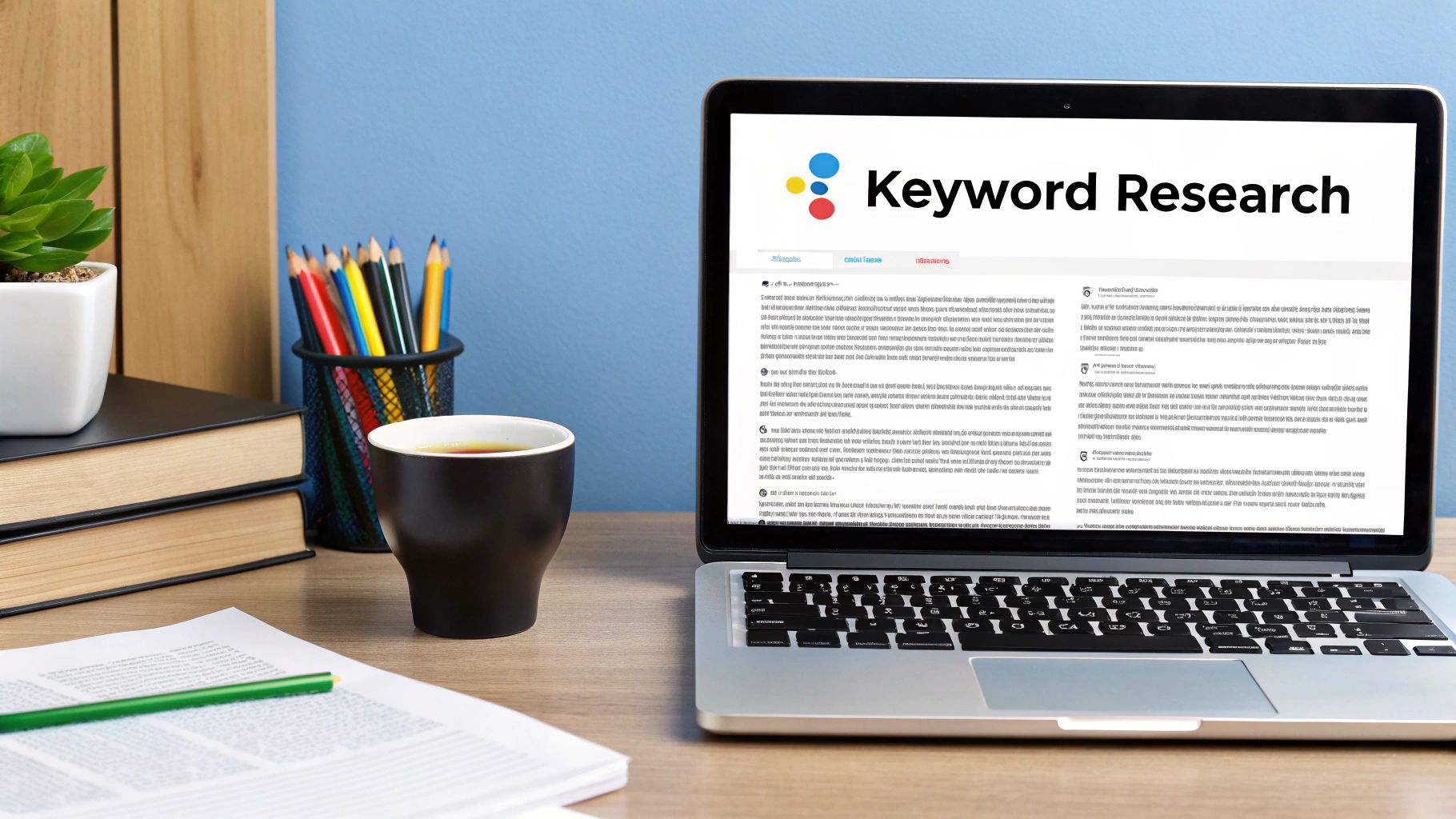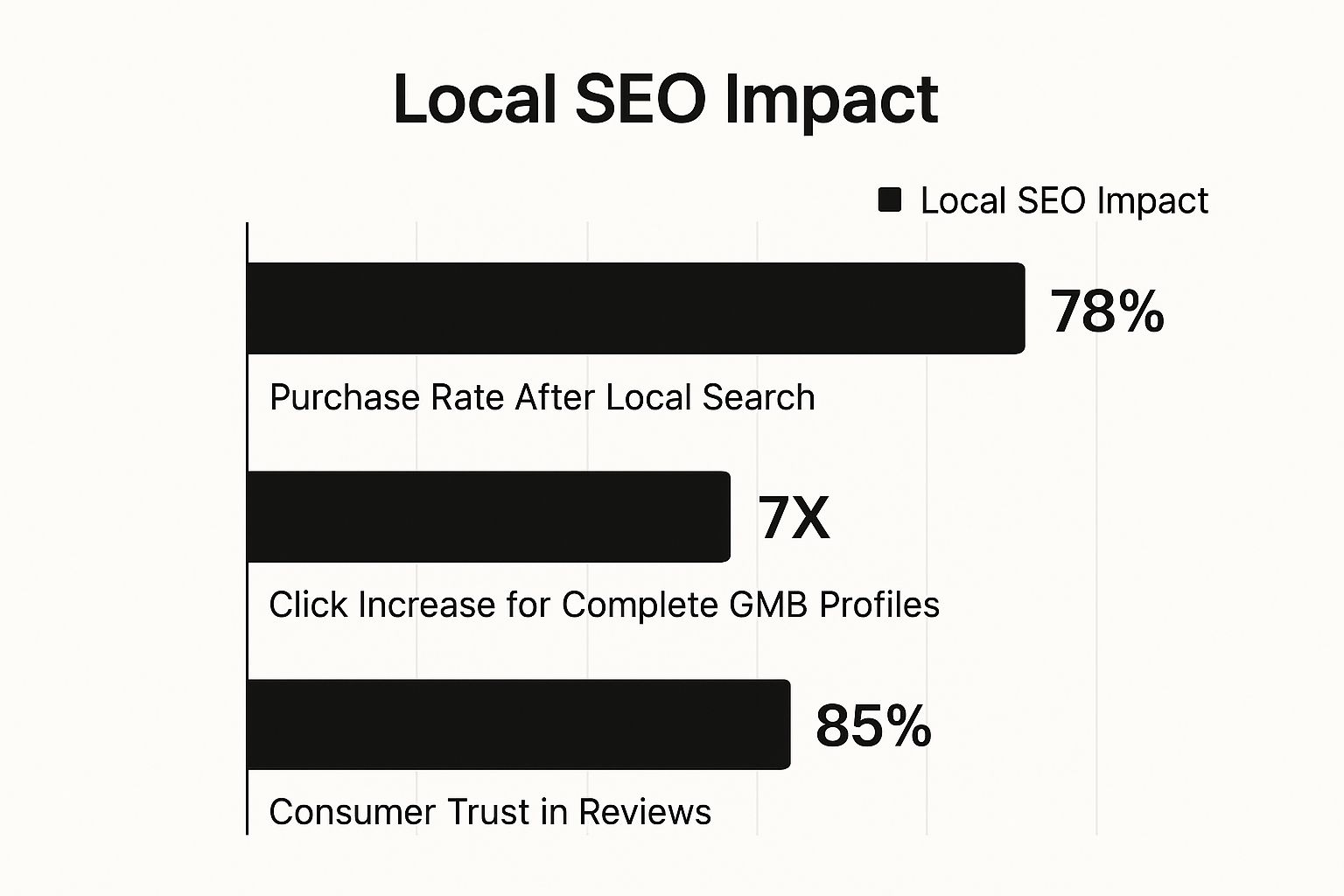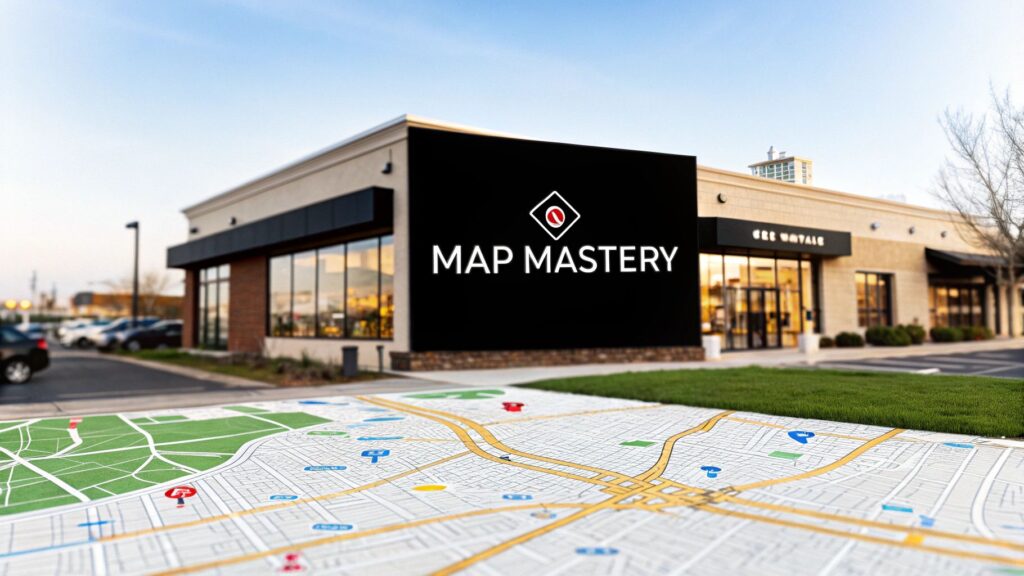When a pipe bursts at 2 AM or a kitchen fire leaves a homeowner in shock, they don’t flip through a phone book. They grab their smartphone and google for help. For a restoration company, good SEO isn’t just marketing—it's your emergency dispatch system. It's what gets you that first, critical call.
A high ranking on Google puts your business at the scene of the crisis, digitally, before your competitors even know there's a problem. Good SEO for restoration companies is the work you do to make sure your website shows up at the very top for urgent searches.
Why SEO Is Your Digital First Responder
In the restoration business, speed is everything. Your customers are in a state of panic, looking for the fastest, most reliable fix for a disaster. They're typing in urgent phrases like "emergency flood cleanup near me" or "24/7 fire damage repair".
Think of it this way: your website is your best truck, fully equipped and ready to roll. SEO is the key in the ignition. Without it, you’re just sitting in the garage, completely invisible to the people who desperately need your help right now.
In Short: SEO connects you with highly motivated customers at the exact moment they need your services, turning their panic into profitable calls.
Turning Panic Into Profitable Calls
The whole point of SEO is to connect you with motivated customers when they need you most. This isn't about casting a wide net. It’s about being the most visible and trusted option for someone facing a property emergency in your service area.
Here’s how this directly helps your business:
- Builds Instant Trust: People trust what Google shows them first. A top ranking acts as a powerful signal of authority, which is important when a customer is stressed and needs to make a quick decision.
- Captures High-Intent Leads: Nobody is "just browsing" for fire damage repair. These searchers have an immediate, expensive problem and are ready to hire someone now.
- Provides Long-Term Value: Paid ads disappear the second you stop paying. A well-ranked webpage is a business asset you own. It can generate leads for years, growing in value over time.
Getting this right is critical. While 81% of customers search online before making a big decision, many small businesses still don't invest in a real SEO strategy. This gap is your opportunity.
People also trust organic results more than ads. Organic search results are 8.5 times more likely to be clicked than paid ads. You can dive deeper into the data on how SEO helps restoration companies grow.
To give you a clearer picture, let's break down the core components of a successful restoration SEO strategy.
The Core Pillars of Restoration SEO
A quick look at the essential SEO components this guide will cover.
| SEO Pillar | What It Is | Why It Matters for Restoration |
|---|---|---|
| Keyword Research | Finding the exact phrases your customers use when searching. | You need to show up for terms like "water damage repair [Your City]" not just generic terms. |
| On-Page SEO | Optimizing your website's pages (titles, content, images) for search engines and users. | This tells Google you're the most relevant answer to a searcher's urgent problem. |
| Google Business Profile | Your free business listing on Google Maps and Search. | This is the #1 driver of local calls. A well-managed profile puts you on the map—literally. |
| Citations & Reviews | Ensuring your business name, address, and phone number are consistent online, and getting customer reviews. | Builds trust and local authority. Reviews are often the tie-breaker for panicked homeowners. |
| Content Marketing | Creating helpful articles that answer your customers' questions. | Establishes you as the expert and captures people earlier in their decision-making process. |
| Link Building | Getting other reputable local websites (like a plumber or roofer) to link back to your site. | These links act as "votes of confidence," boosting your website's authority in Google's eyes. |
Each of these pillars works together. In the following sections, we'll unpack each one so you have a clear, actionable plan.
Step 1: Finding the Keywords Customers Use in a Crisis
When a customer's basement is flooding, they aren't searching for "water mitigation solutions." They're typing "emergency flood cleanup near me" into their phone.
Getting inside the head of a panicked homeowner is the key to effective keyword research. Stop thinking like a restoration expert and start thinking like someone whose world just got turned upside down.
Your goal is to make sure your website is the first thing they see when they search for help. We're hunting for high-intent keywords that scream "I need a professional, and I need them yesterday."

Think Like Your Customer
Before you use any tools, just grab a notebook. Brainstorm a few disaster scenarios and write down the exact words you'd google in that situation.
- A pipe just burst in your kitchen at 3 AM.
- You smell a musty, damp odor coming from a wall.
- A small fire in the garage left a smokey mess.
What phrases come to mind? Probably things like "24/7 burst pipe repair Austin" or "smoke smell removal company." This simple exercise is the foundation of a keyword strategy that gets calls.
How to Find High-Intent Keywords
Once you have a baseline of ideas, you can use free tools to expand your list. Google itself is your best friend here.
Just start typing one of your main services, like "water damage repair," into the Google search bar. Pay attention to the suggestions that pop up in the Google Autocomplete feature. These are based on real, popular searches.
You're looking for phrases that include:
- Emergency Modifiers: Words like "emergency," "24/7," "urgent," or "immediate."
- Location Qualifiers: Specific cities and neighborhoods, or "near me."
- Specific Problems: Things like "burst pipe," "sewage backup," or "basement flood."
In Short: Your best keywords are a mix of a service, a location, and a sense of urgency.
After you run a search, scroll down to the "People Also Ask" section. This is a goldmine for understanding customer questions.
What are some common restoration keywords?
Most follow a simple formula: [Service] + [City/Location]. Think "fire damage restoration Dallas" or "mold remediation services near me." Don't forget variations like "water extraction company" or "sewage cleanup services."
How do I find local keywords?
Tack your city, county, or specific neighborhoods onto your service keywords. Tools like Google Keyword Planner (it's free with a Google account) can show you the search volume for these hyper-local terms.
What's the difference between commercial and informational keywords?
It's about intent. A commercial keyword shows someone is ready to hire, like "emergency water removal." An informational keyword shows they're trying to learn, like "what to do after a small kitchen fire." You need both, but your service pages should always target commercial terms.
Building Your Keyword Arsenal
Let's get organized. The goal is to create a core list of keywords for every service you offer.
Primary Keywords (High-Intent, for Service Pages):
- Emergency water damage restoration [Your City]
- 24/7 fire damage cleanup [Your City]
- Mold removal company [Your City]
- Sewage backup cleanup near me
Secondary Keywords (Question-Based, for Blog Posts):
- How to clean up after a flooded basement
- Cost of fire restoration services
- Signs of hidden mold in walls
This list is the blueprint for your website. Every primary keyword gets its own service page. Every question becomes a helpful blog post. This strategy ensures you show up for people ready to hire and for those in the early stages of a problem.
How to Dominate Local Search and the Google Map Pack
When a homeowner’s basement is flooding, they aren’t leisurely browsing the internet. They're grabbing their phone and searching for someone who can help right now. This is where SEO becomes an emergency response beacon.
Winning in that moment means winning local search, and that all comes down to the Google Map Pack.
You know that little box with a map and three businesses that pops up first when you search for "emergency water removal near me"? That’s it. For a restoration business, getting into that box is like being the first ambulance to arrive at the scene.

Your Google Business Profile: The Digital Front Door
Your Google Business Profile (GBP) is the engine that gets you into the Map Pack. It’s a free profile that acts as your business’s digital storefront. An empty or outdated profile is the online equivalent of a boarded-up shop—customers will just scroll by.
A complete GBP tells Google your business is active, trustworthy, and exactly what local searchers need. This is the bedrock of local SEO. These core principles are effective for almost any local service business, as seen in these general contractor SEO strategies.
Here's your checklist to get your GBP into shape:
- Claim and Verify It: This is step one. If you haven't done this, stop and do it now.
- Lock Down Your NAP: Your Name, Address, and Phone number need to be 100% identical everywhere online.
- Pick the Right Categories: Your primary category should be spot on, like "Water Damage Restoration Service." Then, add secondary ones like "Fire Damage Restoration Service" and "Mold Remediation."
- Craft a Killer Description: Weave your main keywords in naturally. Talk about your 24/7 availability and the towns you cover.
In Short: Your GBP is often the very first impression a customer has of your business. Treat it with care.
Build Trust Before You Even Speak
A homeowner in a panic needs reassurance fast. Great photos and regular updates on your GBP can build that trust instantly.
- Show, Don't Just Tell: Upload high-quality photos of your clean trucks, your team in uniform, your professional equipment, and before-and-after shots of completed jobs.
- Post Regular Updates: Use the Google Posts feature like a mini-blog. Share a quick tip on preventing mold or highlight a recent five-star review.
- Turn on Messaging: Let people message you directly from your profile. More ways to reach you means more chances to win the job.
The Power of Citations and Reviews
Beyond your profile, Google scans the web for other clues that you’re a legitimate local business. This is where citations and reviews come in.
A local citation is any online mention of your business’s name, address, and phone number (NAP). Think of places like Yelp, Angi, and the Better Business Bureau. Every time Google finds your consistent NAP on a trusted site, it's like another vote of confidence for your business.
Reviews are also a huge ranking factor. Google’s job is to recommend the best businesses, and nothing says "best" like a long list of happy customers. Always ask your clients for a review and make it simple by sending them a direct link. Just as important: respond to every single review, good or bad.
Designing a Website That Turns Panic into Action
Let's be real. When a homeowner finds your website, they aren't just browsing. Their basement is flooding, their kitchen is full of smoke, and their heart is pounding.
In that critical moment, your website has one job: turn their panic into a phone call. This is where sharp design and smart on-page SEO for restoration companies become your most powerful tools. They need two things instantly: proof you can fix their nightmare and an obvious way to call you.
If they have to hunt for your phone number, you’ve already lost them. The user experience has to be built for pure speed and clarity.
Make Your Phone Number Impossible to Miss
I'm not exaggerating. Your phone number should be the star of the show on every single page. A customer in crisis should be dialing your number in under three seconds, without ever having to scroll.
- Stick it in the Header: Place your number in a big, bold font in the top-right corner. Make sure it stays "sticky" at the top of the screen as they scroll.
- Make it Click-to-Call: This is non-negotiable. The vast majority of these frantic searches happen on a smartphone. Tapping your number must open their phone's dialer.
- Use Obvious Buttons: Design large, high-contrast call-to-action (CTA) buttons with clear text like "Call for 24/7 Emergency Service" or "Get Help Now."
In Short: Your website isn't a brochure; it's an emergency dispatch center. Every design choice should funnel visitors straight to the "call now" button.
Create a Dedicated Page for Every Single Service
A common mistake is lumping everything onto a generic "Services" page. This kills your SEO and fails to connect with what the customer actually needs. Someone with a sewage backup doesn't care about your fire damage skills.
You need a separate, detailed page for each core service you offer.
- Water Damage Restoration: This page should target keywords like "water damage repair [your city]," "burst pipe cleanup," and "emergency water extraction."
- Fire Damage Restoration: Here, you'll want to target terms like "fire damage cleanup [your city]," "smoke and soot removal," and "fire restoration company."
- Mold Remediation: Optimize this one for phrases like "mold removal company [your city]," "black mold inspection," and "attic mold remediation."
Each page is a chance to show Google you're an authority on that specific topic. More importantly, it shows a customer that you understand their unique crisis.
Build Instant Trust with On-Page Signals
You're asking someone to let you into their home during a stressful moment. They have to trust you fast. Your website needs to scream professionalism.
- Show Off Your Certs: Your IICRC certification logo should be front and center.
- Use Real Photos, Not Stock: Show off high-quality pictures of your actual team, your branded trucks, and your equipment on a real job site.
- Sprinkle in Reviews: Weave real customer testimonials throughout your website, especially on your service pages. Learning how to use effective website testimonials can make a massive difference.
When you combine a phone number they can't miss, service pages that speak to their problem, and powerful trust signals, your website becomes a high-performance conversion machine.
Building Authority with Content That Solves Problems
Smart SEO for restoration companies goes beyond just being there when disaster strikes. It's about building trust long before an emergency ever hits. This is where your content strategy makes all the difference.
When a homeowner spots a small leak or smells something musty, their first stop is Google. You want to be the one giving them the answers. This approach builds brand recognition and establishes you as an authority. When that small problem becomes a full-blown emergency, your company is the first one they remember.

From Simple Questions to Emergency Calls
Picture the journey of a potential customer. They probably aren't searching for your company by name yet. They're typing in questions about their immediate problems. This is your chance to connect with them by creating content that hits those pain points directly.
Doing this sets you up as a credible, helpful resource, not just another business pushing for a sale.
What Kind of Content Should I Create?
Your content needs to be practical and easy to follow. Ditch the industry jargon and talk like you’re explaining something to a worried neighbor. The goal is to solve their problem.
Here are a few blog post ideas that get results:
- Checklists and How-To Guides: Think "What to Do in the First 15 Minutes After a Pipe Bursts."
- Preventative Tips: Articles like "5 Hidden Signs of Mold Growth You Shouldn't Ignore" are very helpful.
- Answering Common Questions: Simple, direct posts like "How Long Does Water Damage Restoration Actually Take?" can be a huge relief for a homeowner.
In Short: Create content that answers the questions your customers are asking before they need you. That’s how you build the trust that makes them call you when an emergency strikes.
Don't Forget Hyperlocal Service Pages
While blog posts attract people seeking information, you also need landing pages aimed at customers ready to hire you now in specific locations.
Instead of a single "Mold Remediation" page, you need to get granular. Create targeted pages like:
- Mold Remediation in [Your City]
- Mold Remediation in [Neighboring Town A]
- Mold Remediation in [Neighboring Town B]
Each page needs to be unique. Mention local landmarks or talk about common issues in that specific area (like flooding near a certain river). This sends a powerful signal to Google that you are the local expert for that service in that town. This strategy is a cornerstone of any solid local service marketing plan, as seen in this marketing plan for foundation repair contractors.
When you combine helpful blog content with laser-focused local service pages, you've got a killer one-two punch.
How SEO Delivers a Better ROI Than Paid Ads
When you need your phone to ring right now, throwing money at paid ads can feel like the fastest solution. But relying on them entirely is like renting your leads. The second you turn off the ad spend, your phone stops ringing.
On the other hand, a solid SEO strategy for restoration companies is about building a real, lasting asset for your business. It's an investment that pays dividends for years to come.
Think of it like this: paid ads are a sugar rush. You get a quick burst of energy, but it fades fast. SEO is like planting a fruit tree. It takes some initial effort, but eventually, that tree starts producing a steady, reliable harvest of leads, season after season.
The Long-Term Financial Advantage
The return on investment (ROI) with SEO isn't just a little better; it can completely change your business's financial health. Organic search converts 84.62% more users than pay-per-click ads. That’s because SEO connects you with homeowners who are actively and desperately searching for help.
Over time, a smart SEO plan can slash your lead acquisition costs by around 61% compared to outbound marketing tactics. It’s about building a stable, profitable lead machine that doesn't leave you at the mercy of rising ad prices.
This chart drives home how much local search influences your customers.

As you can see, a complete Google Business Profile and a steady stream of positive reviews directly builds the trust that makes customers call you instead of your competition.
SEO vs PPC for Restoration Leads: A Cost-Benefit Analysis
To understand the difference, let's break down how these two approaches stack up.
| Feature | Organic SEO | Paid Ads (PPC) |
|---|---|---|
| Upfront Cost | Moderate (content, optimization) | High (can be thousands per month) |
| Lead Flow | Starts slow, grows exponentially | Immediate, but stops when you stop paying |
| Long-Term ROI | Excellent; becomes a business asset | Poor; no lasting value, it's a rental |
| Trust Factor | High; seen as a credible, authoritative choice | Lower; users know it's a paid advertisement |
| Cost Per Lead | Decreases over time as your authority grows | Fluctuates, often increases with competition |
While PPC offers instant gratification, SEO is the winner for building a sustainable and more profitable business. The value you build is yours to keep.
Why Organic Clicks Are Just More Valuable
People simply trust organic search results more than they trust ads. When you show up at the top of Google organically, it feels like a genuine endorsement from the search engine.
This trust gap translates directly into results:
- Higher Click-Through Rates: The #1 organic spot on Google gets way more clicks than any of the ads surrounding it.
- Instant Credibility: Ranking organically positions you as a leading expert in your local area.
- Compounding Growth: SEO has a snowball effect. The authority you build this month helps you rank even higher next month.
A smart strategy might involve using both. You can dive deeper with a detailed comparison between PPC and SEO for restoration services to see how a blended approach could work. But for long-term, profitable growth, SEO is the undisputed champion.
Got Questions About SEO for Your Restoration Business? We've Got Answers.
Jumping into SEO can feel like a lot. Here are the straight-up, no-fluff answers to the questions we hear most often.
How Long Until My Phone Starts Ringing from SEO?
This is always the first question. The honest answer? It's a process.
You'll likely see small wins in the first 1-3 months, especially from tuning up your Google Business Profile. But the real, game-changing results—the kind that bring a steady flow of leads—typically start showing up around the 4 to 6-month mark.
The first few months are about laying the groundwork. Over time, Google starts to see you as a trusted source, and that's when you'll see your rankings climb for those "I need help now!" keywords.
Should I Try to Do This Myself or Just Hire Someone?
You can definitely tackle some parts on your own. Keeping your Google Business Profile fresh with new photos and asking clients for reviews are things you can manage in-house.
But the deeper, technical stuff like advanced keyword research, link building, and writing content week after week takes a serious amount of time and expertise. An agency that lives and breathes this stuff has the systems to get you results faster. It really comes down to what your time is worth.
Local SEO vs. National SEO: What's the Difference and Which One Do I Need?
For a restoration company, this one's easy: local SEO is everything. Period.
Your customers are in your city, your county, your service area. Your entire online presence should be laser-focused on showing up when they search locally.
Forget about ranking across the country. Put all your energy into:
- Making your Google Business Profile the best in town.
- Going after local search terms like "fire damage cleanup in San Diego."
- Getting tons of great reviews from local customers you've helped.
You don't need to be famous nationwide. You just need to be the undeniable first call for anyone facing a disaster in your own backyard.
Ready to stop worrying about where your next job is coming from? At Clicks Geek, we build dominant local SEO strategies that make your phone ring. Get in touch with us today to see how we can help you own your local market.
Is Your Business Ranking in Google Maps?
Turn Google Maps into a Lead Engine w/ Clicks Geek’s AI-powered local SEO. 3,000+ clients served. Our proprietary, fully done-for-you Maps SEO system handles everything—keyword targeting, local optimization, content, reviews, and ranking strategy—automatically.






